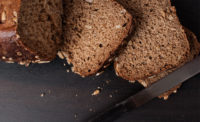The Bottom Line:
- Leavening agents do a lot of work
- Ingredients can help with clean-label goals
- Suppliers are crafting novel leavening ingredients
Leavening ingredients are like a behind-the-scenes work engine—they help with lifting and creating the color, taste, and texture, in many of the baked goods products. As with many other categories, there is a push for clean-label solutions.
“As the push for cleaner label continues, more bakers are opting for aluminum-free leaveners. Bakers can also reduce the sodium content in their products by using calcium-based or potassium-based leavening acids. This works best for tortilla or sweet good products,” explains Yanling Yin, director of research development and applications for bakery, Corbion, Lenexa, KS.
New ingredients
Cam Suarez-Bitar, director of marketing and public relations, Bellarise (Pasadena, CA), notes a growing trend is the continued development of artisan-style breads, at the commercial and industrial level. Artisan baking requires long production times and processes that yield relatively unpredictable results.
To that end, the company recently developed two new leavening-related improver solutions: Fermenta and Crust Enhancer. When baking artisan-style breads at scale, leavening agents like these expedite the baking process while maintaining quality and consistency. Industrial and commercial bakeries can easily and quickly achieve the flavors and textures usually found in long-fermented breads with Fermenta, while they can achieve the right level of crust caramelization with Crust Enhancer. Both of these new custom enzyme-based solutions help bakeries achieve authentic artisan-style breads while simplifying production.
“Bellarise Fermenta blends a proprietary blend of fermented flour and dough conditioning suite into one clean label and non-GMO bread improver,” explains Suarez-Bitar. “Since we made sure that bakeries could still use their preferred yeast with Bellarise Fermenta, the production process remains familiar since bakers know how much gassing power to expect even as they work with new artisan-style breads. Authentic artisan-style flavor and texture are now possible without needing a mother sponge, which further simplifies production and lowers costs. Some applications include artisan breads, pizza crusts, and rolls.”

“Bellarise Crust Enhancer produces natural sugars to help with caramelization, which allows it to play a role as a yeast food while enhancing yeast’s gassing power,” he adds. “When tested in pizza crusts, bagels, and other breads, we see that Bellarise Crust Enhancer helps commercial and industrial bakeries achieve crust color without overbaking their breads.” Both custom-enzyme-based solutions work well in various lean or sweet baked goods, especially artisan-style breads.
“Sourdough is not new by any means, but is has seen exponential growth since the start of the COVID-19 pandemic; in fact, total sourdough bread sales have increased nearly 10% since 2019,” says Melike Ceren, business-to-business marketing team lead, Lesaffre, Milwaukee. “The types of sourdough products are also growing, with sourdough pizza crusts, doughnuts, and pretzels joining the more common bagels, rolls, and cracker. Traditional sourdoughs require regular and continuous feeding, consistent conditions and temperatures, and experienced labor to maintain the fermentation process.”
Lesaffre offers Livendo devitalized sourdoughs that do not require feeding, can be stored at room temperature for 18 months and can be used by simply incorporating into flour. The company recently expanded their Livendo Devitalized Sourdoughs and added a few new offerings. Ceren describes the features and benefits of these new products.
- Mild Wheat Germ: a wheat-based powder ingredient with ripe wheat and toasted aromatics and a suggested usage level of 1-5%
- Light Spelt: a spelt-based powder ingredient with dairy and slightly acidic aromatics and a suggested usage level of 1-3%
- Mild Buckwheat: a buckwheat-based powder ingredient with smokey and slightly acidic aromatics and a suggested usage level of 3-8%
The biomass (mass or population of microorganisms present in the sourdough) of devitalized sourdoughs has been deactivated by a heat treatment that extends the use-by date to up to 18 months while retaining the aromatic properties. Livendo enriches the taste, texture, color, and sensory profile of baked goods—consistently—without requiring the sourdough experience
Corbion recently launched two new enzyme-based clean label dough conditioners/improver solutions. “Pristine 3000 and Vantage 2060 allow for improved gas retention capacity in a dough system when a chemical dough improver is removed. Pristine 3000 supports ‘oven kick’ (the final burst of rising after a loaf of bread is put in the oven before the crust hardens) due to improved gas retention capacity in keto breads or buns. Pristine 3000 is mainly used in yeast-leavened products. Vantage 2060 can be used in either yeast or chemical leavened products (i.e., bread, buns, flatbreads, tortillas),” shares Yin.
While AB Mauri has a full line of leavening agents to meet the requirements for most baked goods, the company has been working on the use of leavening agents in their Indulge line of cake and doughnut mixes, as well as their Supremo line of tortilla mixes, according to Troy Boutte, PhD., vice president of innovation, AB Mauri North America. “We’ve also recently developed a doughnut mix for making a mochi-style doughnut which is relatively new to the US market. Mochi doughnuts are quite different from the typical US-style doughnut and required some modifications to the leavening system. We are also developing a vegan cake mix, which also required adjustments to the leavening systems. Regarding tortillas, we have developed several keto products which are also new to the market. These are excellent products that quite a few people actually prefer over the control tortillas.”
New opportunities
Suarez-Bitar notes that instant dry yeast is becoming more and more popular. This ingredient provides a few advantages: two-year shelf life, ambient shipping, and storage requirements, and consistent gassing power throughout the entire shelf life; make it reliable and easy to use. Semi-dry yeast is also being used more in frozen baked goods and snacks since it provides a more reliable rise in frozen doughs and extends the frozen products shelf life to one year.
Bakery manufacturers will continue to look for cleaner-label leavening ingredients that comply and can drive production efficiencies but still elevate baked goods’ color, taste, and texture.



